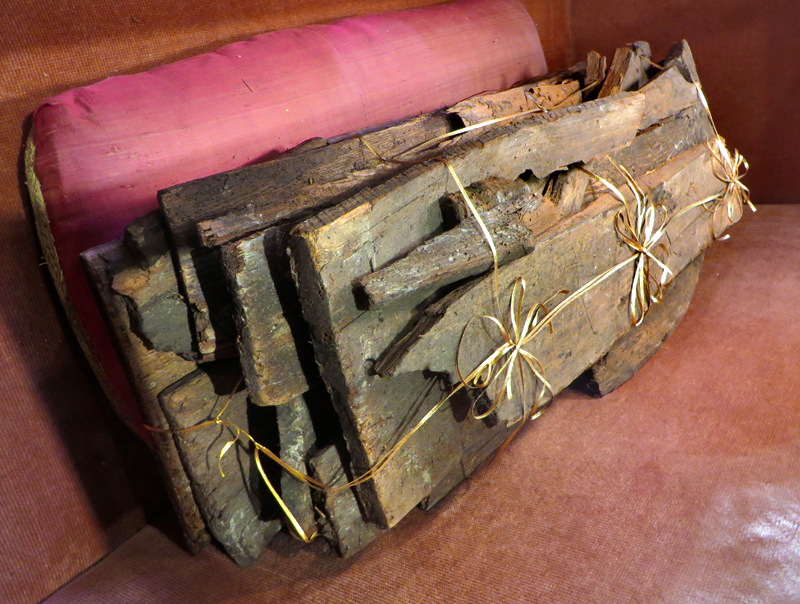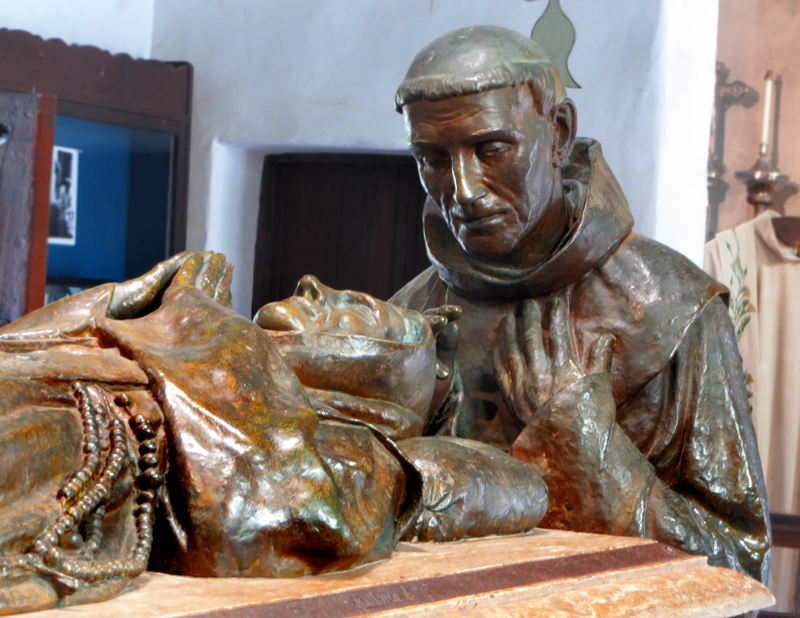|
|
Have We Sucked the Life Out of Our River?
Portolá's Engineer Provides a Picture From the Past
By Leon Worden
SCVHistory.com | Wednesday, October 6, 2004
|
[CLICK HERE FOR COSTANSÓ'S COMPLETE DIARY] Environmentalists allege that our valley's water table has been dropping the last few years because we're growing too fast and the water agencies are overpumping the Santa Clara River. The water agencies say that if well levels on the east side of town are dropping, it's because we've had below-average rainfall the last few years. That's the "short-term" debate. What about the long term? Has the dramatic growth of the Santa Clarita Valley in the last 50 or so years, and citrus farming downstream for 100-plus, reduced the river to — as one politician rather scandalously termed it — a "chunk of dirt?" I should note that in the case of our river, looks are deceiving. Most of the Santa Clara's water is below ground. It provides about half of our drinking water each year. But did the river ever look different? Was there more water in it prior to the introduction of concrete to our valley? A local activist asked me recently about the condition of the river when the Spanish explorers came through the SCV on their trek from San Diego to San Francisco in the 1700s. Is it true that there was so much water flowing above ground, you could navigate a Spanish galleon through it? We were a wetter valley until the end of the Middle Horizon period 800 years ago when the West entered a prolonged drought period that we're still in. But a rushing river just a couple of centuries ago? It sounds like the stuff of urban legend. Although old-timers may remember water flowing above-ground even into summer, photographs from the early 1900s — prior to tract housing — show a riverbed that doesn't appear appreciably different from today. But what the heck. Let's turn back the clock 235 years. Miguel Costansó set out from the Presidio at San Diego on July 14, 1769. An engineer, Costansó was one of 63 soldiers, settlers and missionaries who accompanied Gov. Gaspar de Portolá and Father Junipero Serra on their journey up the coast to Monterey. (They would overshoot Monterey and "discover" San Francisco Bay.) Lucky for us, Costansó kept copious notes, which he compiled into a diary on Feb. 7, 1770, upon his return. His diary was ultimately forwarded to Charles III, King of Spain, as the official report of the expedition. A violent earthquake struck July 28 and the aftershocks were still coming as the party headed north from Los Angeles in early August. "Tuesday, August 8. We entered the mountain range" — the Newhall Pass — "the road having been already marked out by the pioneers who had been sent ahead very early in the morning. Part of the way we traveled through a narrow canyon, and part over very high hills of barren soil, the ascent and descent of which were exceedingly difficult for the animals." Crossing into the SCV at Elsmere Canyon, the old Indian trail was a quarter- to a half-mile east of (later) Beale's Cut and state Route 14. "We descended afterwards to a little valley where there was an Indian village; the inhabitants had sent us messengers to the Valle de Santa Catalina" — the San Fernando Valley — "and guides to show us the best trail and pass through the range..." "The country from the village to the watering-place is pleasing and picturesque on the plain, although the surrounding mountains are bare and rugged. On the plain we saw many groves of poplars and white oaks, which were very tall and large. The watering-place consisted of a stream, containing much water, that flowed in a moderately wide canyon where there were many willows and poplars." This was presumably Elsmere Creek. "Near the place in which we camped there was a populous Indian village; the inhabitants lived without other protection than a light shelter of branches in the form of an enclosure." Costansó describes the Tataviam. Their village of Tochonanga, somewhere in Newhall, has not been discovered in modern times. It may have been near Eternal Valley Cemetery. Aug. 9 was a day of rest. "Before our eyes extended vast mountain chains which we had necessarily to enter if we wished to continue our course to the north or northwest. ... It was decided (to follow) the course of the stream, if possible, as far as to the sea." Through sign language, the Tataviam told the Europeans to take the coastal route. "During the night the scouts returned and reported that the land which led to the coast was level and contained plenty of water and pasture; they had not been able to see the ocean..." Next day the party reached the Santa Clara River. "Thursday, August 10. We traveled for three leagues through the canyon which still ran in the same direction, west-southwest. We halted on the bank of the stream which, at the time of our arrival, flowed with considerable volume, but, shortly after, dried up with the heat of the sun — just as the scouts told us they had noticed on the previous day. This peculiarity we afterwards observed in other streams; they flowed by night and became dry by day." "All the soil of this canyon is very boggy, treacherous, and of a whitish color; the animals sank into it at every step. This canyon was given the name of Santa Clara." "Friday, August 11. ... After three leagues we halted near a populous village situated on another stream of running water" — presumably Castaic Creek. "This emerges from the range through a narrow gorge and empties into the Cañada de Santa Clara, which at this point has a greater width. This village must contain over two hundred souls. ... Today we have probably seen more than five hundred Indians..." Also undiscovered, Chaguayabit was a large village somewhere at Castaic Junction, where Castaic Creek flows into the Santa Clara River. "Saturday, August 12. In the afternoon, we broke camp and steadily followed the canyon over a road broken by streams and gullies formed by the watershed of the mountain range which is drained by them during the rainy season. We halted on the bank of one of them which still carried a considerable amount of water. We covered three leagues on this day's march." They're heading down the state Route 126 corridor to the ocean. "Sunday, August 13. We marched for two leagues, steadily descending the canyon with the intention of reaching the coast which we presumed to be already near. We pitched our camp at a short distance from the stream — henceforth we shall call it, with greater propriety, a river, on account of its volume at this place, increased by various streams which empty into it on both sides of the canyon. From this place we observed a spacious plain, covered with grass and with some trees, extending to the south and west as far as the sea." "Near our camp there was a very small Indian village; the inhabitants lived in huts thatched with grass, of a spherical form like the half of an orange..." These are coastal Chumash. The party reached Santa Barbara on Aug. 19, San Luis Obispo on Aug. 21, Santa Cruz on Oct. 18 and San Francisco on Oct. 31. It rained almost nonstop during their three-month return trip. On Jan. 12 they "forded the Río de Santa Clara" near Ventura, where they'd camped on Aug. 13. From here they appear to have charted the Highway 101 route south. Now then. What can we deduce from this 18th-century engineer's report? For one thing, it's not true that you could steer a warship through the Upper Santa Clara River. However, our valley's water table appears to have been higher. Even in the dead of summer, water flowed above-ground by night — and dried up by day, leaving a shallow quicksand. Current policy in Santa Clarita is to pump the river each year to its "maximum safe yield," knowing it'll recover in wet years. Where the environmentalists and water agencies disagree is in the definition of "safe." Traveling down the corridor, the Santa Clara went from "stream" to "river" on the approach to Ventura. This makes sense. If Portolá and his explorers were five leagues — 15 miles — from Castaic Junction when they pitched camp and started calling the Santa Clara a "river," they were west of Blue Cut. A natural formation, Blue Cut is a wall of bedrock near the Los Angeles-Ventura county line that marks the western border of our valley's water basin. Water officials say the bedrock forces the subsurface flow to come to the surface as it travels west, creating an above-ground "river" from that point on. During summer today, however, the Lower Santa Clara River looks nearly as dry as the upper where it meets the ocean — even though we're pumping billions of gallons of imported state water into the river after we use it. Why? Well, there was no organized citrus farming 235 years ago. The downstream United Water Conservation District diverts water from the Santa Clara River for irrigation. So, what is reducing our river to a "chunk of dirt"? Is it the concreting of Santa Clarita? The introduction of agriculture in Ventura County? Is it simply the continuation of the "drying out" that started around AD 1200? Or, is it some combination of all of them? To read Costansó's complete diary of the Portolá expedition, click here. ©2004 LEON WORDEN | ALL RIGHTS RESERVED
|
Story: Rio Santa Clara in Costansó's Diary Perkins Manuscript: Colonization
Junípero Serra (1)
Junípero Serra (2)
Juan Crespí Story
Graves of Serra, Crespí, Lasuen
Serra's Coffin
Serra Cenotaph
Pedro Fages
Fages Marker
Francisco Garcés
Early Afro-Mexican Settlers (Video 2015)
|
The site owner makes no assertions as to ownership of any original copyrights to digitized images. However, these images are intended for Personal or Research use only. Any other kind of use, including but not limited to commercial or scholarly publication in any medium or format, public exhibition, or use online or in a web site, may be subject to additional restrictions including but not limited to the copyrights held by parties other than the site owner. USERS ARE SOLELY RESPONSIBLE for determining the existence of such rights and for obtaining any permissions and/or paying associated fees necessary for the proposed use.









